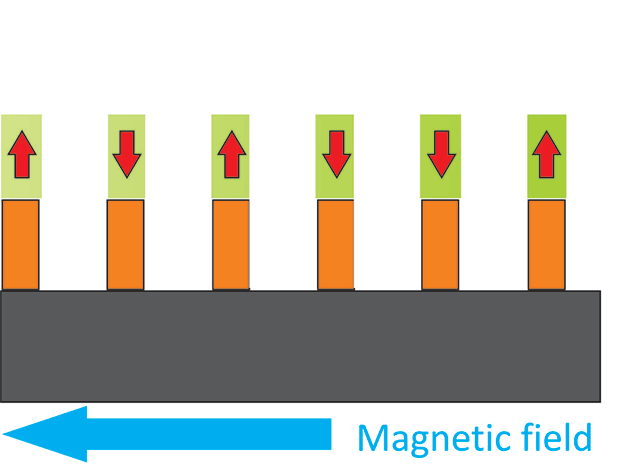Data storage density has doubled every three years since magnetic storage was first developed in the mid-1950s. Key technological innovations along the way such as giant magneto resistance (GMR), perpendicular magnetic recording (PMR) and heat-assisted magnetic recording (HAMR) have fueled that enormous growth in capacity. Despite this continually increasing storage density, there is a growing sense that this upward trend is beginning to lose steam.
Now researchers at the Helmholtz Zentrum Berlin (HZB) have developed a new technique with a new kind of material that could move magnetic storage technology beyond the current state-of-the-art HAMR technology and lead to faster and more energy efficient ultrahigh density data storage.
With the continuing push to increase data density in magnetic storage, the tiny magnetized regions of the material known as bits have had to shrink continuosly. The problem has been that as these bits started to get down to a few tens of nanometers, they became unstable and would flip their magnetization in the presence of a small amount of heat.
The solution has been HAMR in which the bit is heated with a focused light beam. In this way, heat became an advantage rather than a disadvantage and the materials could hold magnetization when only a few nanometers across.
In research published in the journal Physical Review Applied, instead of using the iron-platinum materials that are typically used in HAMR-based data storage devices, the scientists sputtered thin films of the elements dysprosium and cobalt onto a nanostructured membrane. Researchers at the Institute of Materials Science of Madrid produced the membrane.
The combination of the membrane and the thin films of dysprosium and cobalt sputtered on top of it created a honeycomb pattern in which the nanoholes are 68 nanometers in diameter and the distance between each hole is 105 nanometers.
One of the key features of the resulting material is its stability. The nanoholes serve as pinning points for stabilizing magnetic wall displacements and the magnetic moments of the material occur perpendicular to the plane so they remain stable even in the presence of an external magnetic field.
While stability is a major benefit of the resulting material, the HZB researchers believe the strongest feature of their approach is that they could write patterns of magnetization on the material quickly and only needed to heat the sample to 80 degrees Celsius.
“This process in DyCo5 [dysprosium-cobalt] is energy efficient and very fast,” said Florin Radu, co-author of the study, in a press release.
Jaime Sánchez-Barriga, lead author of the research, added: “Our results show that there are alternative candidates for ultrahigh density HAMR storage systems, which need less energy and promise other important advantages as well.”
Dexter Johnson is a contributing editor at IEEE Spectrum, with a focus on nanotechnology.


